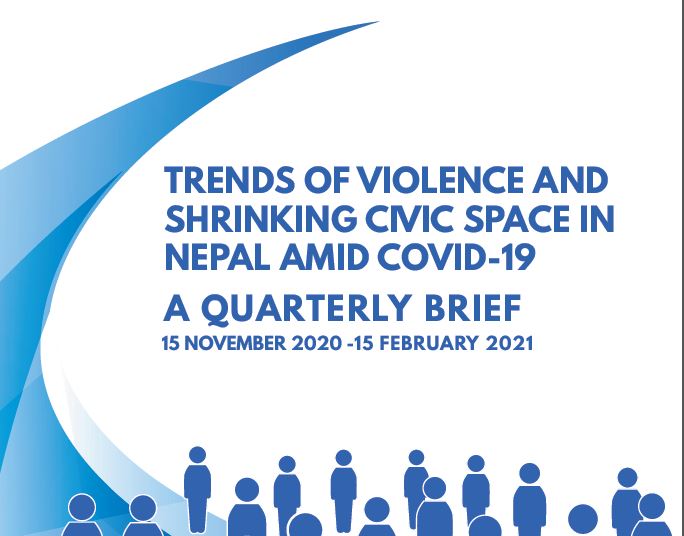Analysis
TRENDS OF VIOLENCE AND SHRINKING CIVIC SPACE IN NEPAL AMID COVID-19, 15 NOVEMBER 2020 -15 FEBRUARY 2021
2021-03-15

This report from the Violence Monitoring and Shrinking Civic Space in Nepal amid Covid-19 (VMSCS) Project evaluates trends of violent and nonviolent public contestation with the objective of presenting their impact on civic space in Nepal from 15 November 2020-15 February 2021. Data of violent and non-violent incidents are compiled from reports of all major online news portals, national and local newspapers, Nepal Police, Civil Society Organizations (CSOs) working for human rights, and incident reports directly submitted to the Collective Campaign for Peace (COCAP).
OVERVIEW OF INCIDENTS FROM 15 NOVEMBER 2020 – 15 FEBRUARY 2021
From November 2020-February 2021, the VMSCS recorded 1081 incidents. Of the total incidents recorded, 36.26% were violent and 63.73% were non-violent in nature. Out of 392 violent cases recorded in this quarter, 57 people lost their lives.
Among 392 violent incidents, 205 incidents were of sexual assault, 58 of violent small group assault, 41 included cases of murder/attempted murder, 32 incidents of violent group clash, and 23 cases of vandalism. The causes to it involved gender-based violence incidents relating to rape and sexual assault, domestic violence and violent demonstrations over the constitution and federal restructuring.
Out of 689 non-violent incidents, VMSCS recorded 466 events mainly involving demonstrations and protests against the government, 97 events relating to sit-in/ padlocking, and 38 riots concerning politically significant arrests of the cadres. The primary causes of it was the political contestation over constitution and federal restructuring, governance issues related to legal action and access to justice, lack of quality and access to public services (health, education etc).
The Non-violent incidents mainly involved peaceful demonstrations, protests, and rallies, followed by sit-ins/padlocking, mostly around the Prime Minister KP Oli’s proposal towards the dissolution of the Parliament. Also, there were 38 reports witnessing the Politically significant arrest of the cadres during this quarter, which included 63 arrests of the banned CPN (Chand-led) Cadres, 19 arrests of the Prachanda-Madhav faction cadres. Likewise, 16 incidents of road block, 13 of threat and intimidation, and 12 incidents of strike were also recorded in this quarter. The majority of such incidents, did not have any violent impact, and no any form of physical force was used as a target towards the affiliated actors involved in the contestation, which somehow portrays that there is a space for the civilians, civil society and other actors to exercise their rights to freedom of expression and to assemble peacefully.
This quarter witnessed the space for HRDs, journalists and civil society increasingly being constricted in Nepal. Besides legislative measures that imposed various administrative hurdles and restrictions, HRDs and media personnel working in the field frequently face intimidation and threats. This held true for journalists reporting news surrounding irregularities of the government’s Covid-19 response too.
Continued violence against human rights defenders (HRDs) and journalists, as well as the introduction of various controversial bills and police intervention during peaceful demonstrations, have all contributed to the deterioration of Nepal’s human rights and civic space in recent years. Currently, Nepal has the strongest ever government led by Nepal Communist Party (NCP) with two-thirds majority. Despite adopting the slogan “Prosperous Nepal, Happy Nepali” the government’s recent actions are aimed at shrinking civic space and silencing the critical mass. The government’s recent actions have alarmed Nepal’s civil society, media, and human rights organizations.

